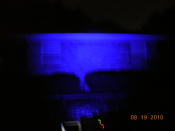I have been building a few of Pondudes rainbow floods and have been very impressed with the colour and light output that these give for under US$15. I have found the perfect cover (with the help of Phil  ) for these floods. The covers are from the Horizon Range of 150 watt flood lights that can be bought from Bunnings for AU$10. The flood casing is perfect for the rainbow floods and simple to build.
) for these floods. The covers are from the Horizon Range of 150 watt flood lights that can be bought from Bunnings for AU$10. The flood casing is perfect for the rainbow floods and simple to build.
1: First open the cover of the light and remove all the internal bits from the from the flood, including the reflector, base, wiring and terminal block until you have an empty flood casing.
2: Then solder a short wiring tail directly to the bottom of the board as shown in the picture. Do not solder on the RJ sockets when building the flood board
3: Test the flood board works
4: Place the board into the flood casing, feeding the wire through the hole to the terminal box as shown in the picture
5: Fit the board into the flood casing ensuring it is level and centred and it should wedge into the casing into a perfect position.
6: Use non corrosive silicon to hold the flood board into position
7: Leave for a week to allow the silicone to cure
8: Close up the cover. I used some silicon gel around the gasket to help minimise any chance of water ingress
9: The light is now ready to be connected to any DC controlling board like the tiger 48 or LOR DC board, or even the rainbow brain
The result was easier and better than i had expected as the casing is the perfect fit for these floods and are not difficult to build
1: First open the cover of the light and remove all the internal bits from the from the flood, including the reflector, base, wiring and terminal block until you have an empty flood casing.
2: Then solder a short wiring tail directly to the bottom of the board as shown in the picture. Do not solder on the RJ sockets when building the flood board
3: Test the flood board works
4: Place the board into the flood casing, feeding the wire through the hole to the terminal box as shown in the picture
5: Fit the board into the flood casing ensuring it is level and centred and it should wedge into the casing into a perfect position.
6: Use non corrosive silicon to hold the flood board into position
7: Leave for a week to allow the silicone to cure
8: Close up the cover. I used some silicon gel around the gasket to help minimise any chance of water ingress
9: The light is now ready to be connected to any DC controlling board like the tiger 48 or LOR DC board, or even the rainbow brain
The result was easier and better than i had expected as the casing is the perfect fit for these floods and are not difficult to build









